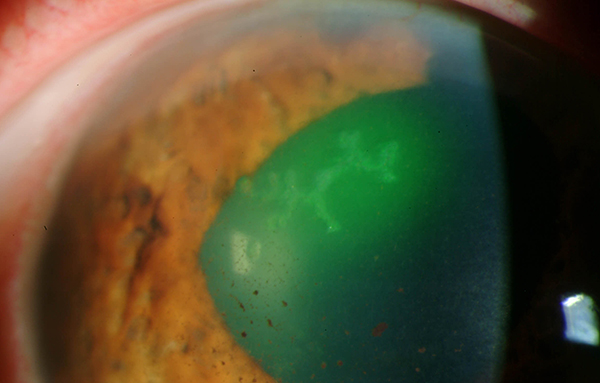 |
| Immunodeficiency is shown to increase the odds of recurrent HSV keratitis. Photo: Chris Sindt, OD. Click image to enlarge. |
Herpes simplex viral (HSV) keratitis can often be misdiagnosed in children, and when it is correctly diagnosed, it’s difficult to cure partly due to patients not finishing treatment. This can lead to susceptibility to amblyopia, among other things. Between these issues and few studies completed on the pediatric population over the last 10 years, researchers recently evaluated the clinical features of pediatric HSV keratitis, its recurrence rates and its effects on visual acuity. They found that stromal involvement plays a major role, and immunodeficiency was found to be significantly associated with recurrence. The authors believe this is the first study to establish a significant relationship between the immunodeficiency and the relapse rate of HSV keratitis in the pediatric age group.
Records of 24 pediatric patients from infants to those 16 years of age (16 females, eight males) who presented with HSV keratitis between January 2012 and September 2021 were evaluated. Age, gender, additional systemic diseases, number of recurrences, recurrence time, treatment protocol, follow-up period and presence of amblyopia were reviewed.
The study showed that the most frequent corneal manifestation of HSV is stromal keratitis that mostly progresses with corneal scarring, residual astigmatism and amblyopia.
Four patients (16.6%) had bilateral keratitis, which is consistent with previous studies. Including these patients, a total of 10 (41.6%) had additional systemic diseases that cause immunodeficiency. After prophylactic antiviral treatment for at least six months (except for isolated epithelial keratitis), a recurrence rate of 50% was detected in five patients, who were all immunodeficient. Keratitis recurrence was significantly associated with immunodeficiency. However, type of keratitis, gender and bilaterality were not related with recurrence, the authors noted.
A total of 46.4 eyes had astigmatism more than 1.50D, and 66.7% of the patients younger than 10 years developed amblyopia during follow-up. Amblyopia was detected in 80% of patients with recurrent disease.
“In conclusion, pediatric HSV keratitis may have important consequences for the development of amblyopia, especially when stromal involvement is present, and each recurrence may worsen the negative outcomes,” the authors noted. “The presence of immunodeficiency is shown to increase the odds of recurrent HSV keratitis; therefore, a detailed evaluation of patient history is crucial, and immunocompromised patients are advised to be followed more closely to detect recurrences early. In the management of pediatric HSV keratitis, a multidisciplinary approach with pediatric infectious disease specialists and pediatric ophthalmologists and close clinical follow-up are essential for a satisfactory visual outcome.”
Ulman EA, Selver OB, Biler ED, Palamar M. Clinical features of pediatric age herpes simplex virus keratitis. Cornea. January 22, 2023. [Epub ahead of print]. |


